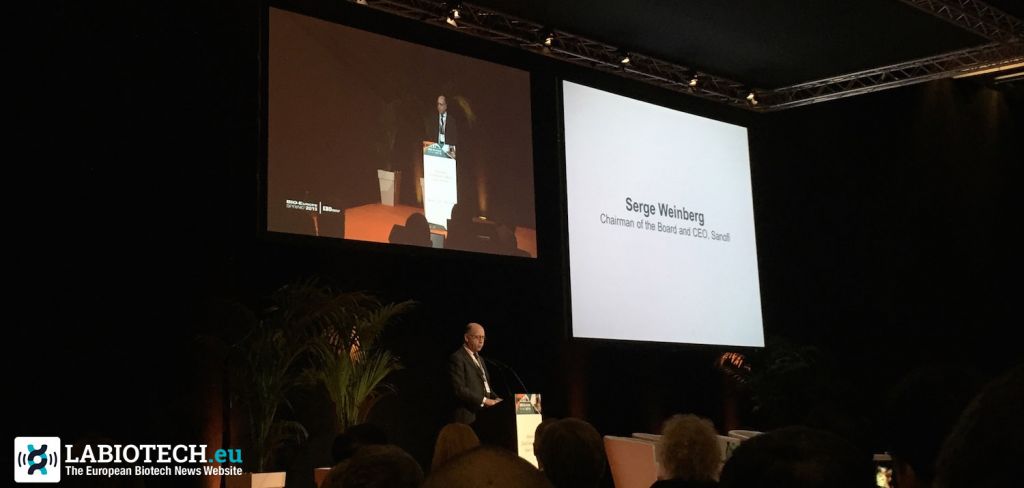Sanofi is France’s largest pharma company and the 3rd biggest in the World. The VIP guest of BIO-Europe Spring was Serge Weinberg, Chairman and temporary CEO of Sanofi. You might have been expecting a boring corporate conference with a strong Frenchy-accent English but actually, the talk was extremely clear and interesting. Weinberg went through Sanofi’s innovation strategy as well as its pivot from Chemistry to Biotech.
Today, Sanofi counts 110 000 employees spread all over the world. A slow giant with many political/organizational/historical difficulties. Sanofi early on understand the importance of innovation in the Biotech/Pharma industry, especially in the field of Biotechnology and in the way innovation occurs today. No company can do everything on its own anymore, because diseases and treatments become more and more complex and multi competencies. Big companies have to open up their research and start collaborating with the external World.
More or less 5 years ago, Sanofi started this shift by focusing on partnerships and on biologicals instead of chemicals. These new drugs, which can be hormones, monoclonal antibodies, vaccines but also more modern therapeutics such as mRNA, siRNA, cell therapy or gene therapy, have an extraordinary potential.
Tough challenge but as Weinberg clearly quoted « We worked hard to transform Sanofi from pharmaceutical to biopharmaceutical ». Results are pretty impressive. Sanofi now has 72% of its pipeline filled with biologicals and even 100% of late stage programs. The size of the pipeline is also impressive. It plans to launch a new medicine every 6 months in the next 4 years. Of course, therapeutics takes between 10 to 15 years to be developed but it could still be seen as a sign of a productive innovation strategy.
But how did it occurred? Sanofi hired a strong leadership to develop their partnering unit. « It is impossible to succeed alone anymore. We have to work with the best scientist, wherever they may be », Weinberg said. The perfect example is the major acquisition of Genzyme for $20Bn, which was exactly driven by this objective. Genzyme is a Boston-based company with an innovation model already relying a lot on partnerships. It gained lot of experience in this field that would then be reinjected into Sanofi’s Business development/alliance units. Genzyme’s acquisition was also a way for Sanofi to jump rapidly in the field of Biotechnology and rare diseases, to be well-established in the heart of the biggest biocluster of the World (Genzyme headquarters are in the middle of Kendall Square, the district next to the MIT with nearly all Biotechs and one the highest density of brains in the World). Of course, Sanofi also acquired or invested in many other companies such as recently, a massive investment in Alnylam, leading siRNA company based 300 meters away from Genzyme HQ.
On the other hand, Sanofi had also to change its internal organization. Most visible decision was to fire over 5000 people in France, for example in Toulouse and Montpellier. It could be that their internal research was not as effective as external innovation and I guess they must have lot of people still specialized in chemistry. It is also a good way to change rapidly the culture of a huge giant. Of course, it is unfair for these people but it is coherent when you look at the big global picture. And while firing employees in France, Sanofi was massively recruiting in Boston with Sanofi’s logo on building all around the city. Chris Viehbacher, former CEO, was a tough and respected leader who thoroughly executed his strategy. He may have been willing to transform the company, but did it too rapidly. Just before being fired, he announced having moved to Boston to manage the company from there and all top-executives of Sanofi were not living in France anymore. Rumors also stated Sanofi’s headquarters could move out of France. As he worked for Laurent Fabius, French minister and very important political figure, Weinberg was highly regarded amongst the French elite. Many French politics and friends of his, must have hated this transformation. Maybe this was the final strow and a pretext to fire him. He may also have been willing to save his golden parachute (several million euros) and move to somewhere else, as LaBiotech’s blogger Romain wrote about it: Is Chris Viehbacher going to impact the Biotech VC field as he changed Sanofi?
To sum up, it was pretty impressive to discover how Sanofi metamorphosed its core activity in a small period of time. I really hit me as I listened to this conference and as I connected the dots. I think Sanofi is now the largest biopharmaceutical company and it is very well positioned for the biotechnological revolution which has just begun.





